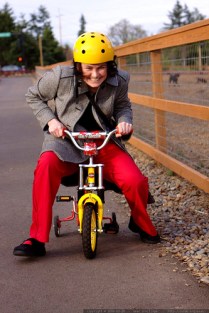
Come on, give it a shot. You'll be glad you did. (Photo by Sean Dreilinger.)
As if you needed further proof that the oil-soaked transportation bill now making its way through the U.S. House of Representatives is out of touch with reality, look no further than the just-released 2012 Benchmarking Report from the nonprofit Alliance for Biking and Walking. The report, which culls its numbers from over a dozen government sources and city and state surveys, is chock-full of evidence of the benefits of biking and walking — and the importance of funding infrastructure to encourage more people-powered transportation.
While biking and walking make up 12 percent of all trips in the U.S., they receive only 1.6 percent of federal transportation funding, according to the report. If House Speaker John Boehner & Co. get their way, that percentage would drop to zero. But Americans — particularly young ones — are sick of sitting in traffic, both literally and figuratively. Biking and walking numbers are up, and they will rise even more if we just support the growing desire to drive less.
Nationwide, the number of people who bike to work is up 57 percent since 2000. It’s still a tiny fraction — 0.6 percent — of all commuters, but there’s reason to believe that more people are interested in making the switch: Grassroots bicycle advocacy is on the rise, and participation in adult bike education courses has grown a whopping 267 percent since 2006. Consider, too, that 40 percent of all trips in the U.S. are less than 2 miles. Clearly, we could be doing a lot more biking and walking, and a lot less driving.
The Alliance’s report gives an in-depth look at the chicken-and-egg way cycling and walking grow: More cyclists and pedestrians on the streets signal to local governments that those modes of transportation deserve more infrastructure investment; improved infrastructure encourages more people to bike and walk; and the cycle continues. Not surprisingly, cities with the most biking facilities (Portland, San Francisco, Minneapolis, New York, and Seattle) generally rank high for biking and walking levels. Places at the bottom of the rankings, like Fort Worth, Dallas, and Jacksonville, have little infrastructure.
Perhaps less obvious, but arguably more significant, are the report’s findings on cyclist and pedestrian fatality rates. You might think that as the percentage of a city’s population that bikes and walks increases, so too does the number of related fatalities. But the opposite is true: Oregon, the state with the highest percentage of people biking to work, reports only 1.4 bicycling fatalities per 10,000 daily cyclists, while Mississippi, in the bottom five for bike commuting levels, reports 14.1 fatalities per 10,000 daily cyclists — the highest of any state. Five of the 10 safest cities for cycling are also in the top 10 for rates of bike commuting.
The same pattern applies to pedestrian safety: Seven of the 10 safest cities for pedestrians also rank in the top 10 for levels of walking to work. The least safe place to walk, Fort Worth, also comes in dead last for pedestrian commuting.
This makes sense. If it’s safe to walk or bike to work, you’re more apt to do it. If it means teetering down the narrow shoulder of a six-lane highway, you’ll probably opt to drive. But there’s something else at work here, too. The report also suggests that in places where walking and biking are common, drivers are more accustomed to sharing the streets with cyclists and pedestrians, and thus more likely to keep an eye out for them. It’s simple safety in numbers.
The report identifies a few things besides infrastructure that influence biking and walking rates. Density is one: Your own two feet are more likely to be your go-to method of transportation if most of your daily destinations are within a few-square-mile area of narrow streets with limited parking. No wonder residents of the largest U.S. cities are almost twice as likely to walk or bike to work than the national average. But the list of the top 10 biking/walking states also includes several decidedly rural ones — Alaska, Montana, South Dakota, Wyoming, and Maine — which suggests that biking and walking are not solely the province of the so-called urban liberal elite.
You can probably guess what the Alliance’s report shows about public health. In general, cities and states with lower rates of biking and walking have higher obesity levels, and vice versa. Memphis, eighth from the bottom in combined biking and walking rates, is the fattest city. San Francisco, the thinnest, has the third-highest biking and waking levels.
Which brings us back to the question of where our transportation dollars are best spent. As America’s obesity epidemic and its attendant health problems drive up medical costs for all taxpayers, encouraging people to bike or walk to work should be a no-brainer. And if a city like Portland can build a complete bike infrastructure for the cost of one mile of highway (about $57 million), it’s hard to see that kind of investment as wasteful spending.
Maybe all we need to do is get Boehner and friends out of their cars for a stroll around the National Mall — or better yet, a spin on one of Washington, D.C.’s groovy red bike-share cycles — and let a little fresh air and exercise set their heads straight.



